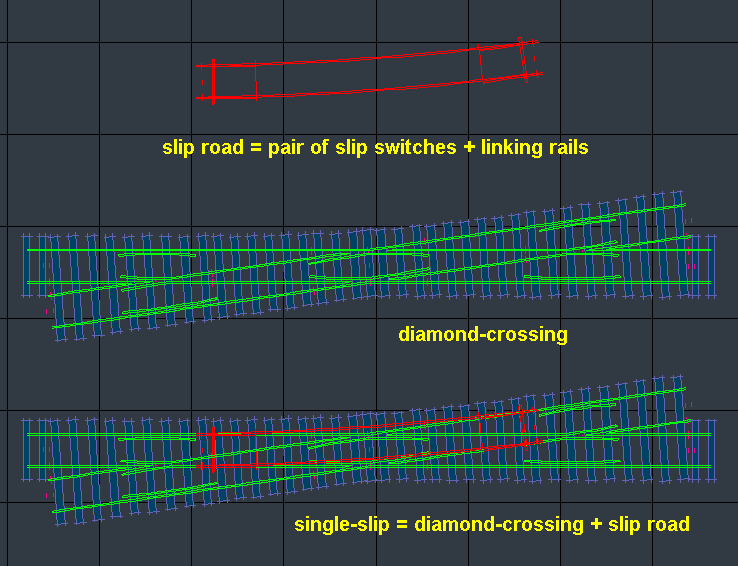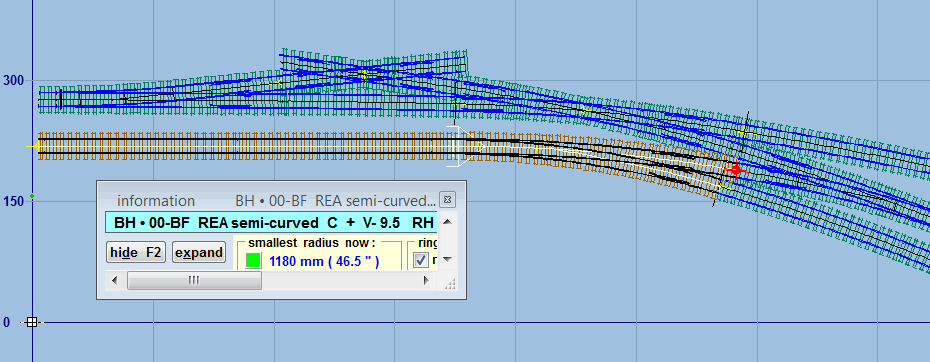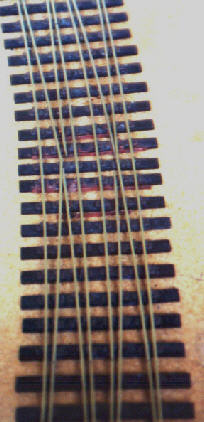Templot Club Archive 2007-2020
|
|||
| author | remove search highlighting | ||
|---|---|---|---|
|
posted: 29 Jan 2012 15:34 from: AndyJ
click the date to link to this post click member name to view archived images |
Hi there... I'm pretty new to Templot and been playing around with it for a while but i'm still struggling with a few bits.. Having taken the plungle in building my own track and just started a new exhibition layout i'm having a bit of a job setting out some point work. Mainly an outside slip with a diamond attatched to it. Could someone point me in the right direction to making this possible... Hopefully the file will be attatched to this post so you can see what i mean. Many thanks Andy |
||
| Attachment: attach_1337_1813_Herstmonceux.box 318 | |||
|
posted: 29 Jan 2012 20:41 from: Alan McMillan
click the date to link to this post click member name to view archived images |
Hi Andy I've run something up for you. An outside slip was never going to work in that tight space, so I took the liberty of replacing it with a single turnout and a double switched diamond slip. I also eased the curve to make it less like it hand been built using Peco Setrack. The start and end points are, however, the same except for the siding that comes off the slip. I haven't done any timber shoving though. Regards Alan |
||
| Attachment: attach_1340_1813_Herstmonceux.box 324 | |||
|
posted: 29 Jan 2012 21:34 from: Stephen Freeman
click the date to link to this post click member name to view archived images |
AndyJ wrote: Hi there... I'm pretty new to Templot and been playing around with it for a while but i'm still struggling with a few bits..Hi, Youo may consider this to be approaching what you want. I think you may well be better off with moving K crossings due to the flatness of the diamond. You might get away with it in P4/EM/00-SF but 00-BF has too much slop IMHO. |
||
| Attachment: attach_1342_1813_market_street_12_01_29_2244_22.box 326 | |||
| Last edited on 29 Jan 2012 21:45 by Stephen Freeman |
|||
|
posted: 29 Jan 2012 22:21 from: AndyJ
click the date to link to this post click member name to view archived images |
Hi Guy's Thanks for taking the time to work on this for me. Alan, I hadn't thought about putting a double slip there but the only problem is there going to be a platform starting around there with the siding behind being a loading dock. Borg-rail, Could you explain to me about moving the K crossings? How would this cause to much slop? Sorry very new to this Cheers Andy |
||
|
posted: 9 Mar 2012 23:23 from: Martin Wynne
click the date to link to this post click member name to view archived images |
AndyJ wrote: Could you explain to me about moving the K crossings? How would this cause to much slop? Sorry very new to thisHi Andy, Using movable K-crossings doesn't cause the slop. By avoiding any break in the rail they prevent the wheels from taking the wrong route. 00 gauge has a lot of side-slop between the wheels and the rails which makes this very likely on fixed K-crossings, and the flatter* the K-crossing angle so the more likely it becomes. Even the prototype insists on movable K-crossings above 1:8. As you are using 00-BF standards I think you would do better to regard say 1:6 as the flattest angle safe for fixed K-crossings. Use switch-diamonds (i.e. with movable K-crossings) for flatter diamonds and slips or even for 1:6 if it is on a curve. There is so much slop in the 00 gauge standards that wheels can very easily mis-track and take the wrong road in flat-angle fixed K-crossings. You could consider tightening things up by using 00-SF instead of 00-BF -- see: http://00-sf.org.uk but I would still recommend a switch diamond for a curved 1:7. In fact a switch-diamond is quite a bit easier to build than fixed K-crossings, the only disadvantage being the need for additional point motors. More discussion here: topic 288 That's a rather old topic and a bit out of date -- Templot2 now supports irregular diamonds directly. *I use the terms "flatter than 1:6" or "longer than 1:6" or "gentler than 1:6" to mean angles from 1:6 to 1:20 or more. regards, Martin. |
||
|
posted: 12 Mar 2012 20:02 from: AndyJ
click the date to link to this post click member name to view archived images |
Thanks Martin... Thats made it alot clearer. Guess I just need to have a go at drawing it now!! Cheers Andy |
||
|
posted: 13 Mar 2012 18:54 from: AndyJ
click the date to link to this post click member name to view archived images |
Hello again people.. Right i'm hoping i've made the switched diamond crossing properly?? Also i'm having trouble shortening the point labled need to make shorter. Cheers Andy |
||
| Attachment: attach_1383_1813_Modified_Herstmonceux.box 290 | |||
|
posted: posted: 14 Mar 2012 00:55 from: roythebus
click the date to link to this post click member name to view archived images |
That turnout no.1 looks horribly sharp, especially if it's on a running line. | ||
|
14 Mar 2012 00:55 from: roythebus
click the date to link to this post click member name to view archived images |
That turnout no.1 looks horribly sharp, especially if it's on a running line. | ||
|
posted: 14 Mar 2012 10:08 from: wcampbell23
click the date to link to this post click member name to view archived images |
Hi Andy You can adjust the switch end of the turnout by choosing a different length of switch. This can make the turnout shorter without affecting the common crossing. You could also tweak the curved turnouts to ease the radii by experimenting with different switch lengths. Regards. |
||
|
posted: 15 Mar 2012 13:58 from: Tony W
click the date to link to this post click member name to view archived images |
AndyJ wrote: Hello again people..Hi Andy. The Switched crossing looks fine to me. I have however altered the timbering of the fixed diamond crossing to suit your oo gauge track K crossings, this can be found under the "Real > timbering > half-diamond timbering > timbering as model" menu, the default is timbering as prototype. The No. 1 turnout shows a minimum radius of 34" which is acceptable in oo. Wcampbell is quite right that changing the switch from C to B will shorten the lead of the turnout, but it is possible to go further by producing a turnout with a shortened lead. This needs to be done with care however as doing so reduces the turnout radius. To do so wipe the turnout to the Control, then with the peg where it is (Ctrl 6) go "Action > mouse actions: control / real > adjust V-crossing entry straight" (or use the Shift + F11 shortcut key, TDV only). As the entry straight lengthens the turnout lead will shorten but the trade off is that the turnout radius will decrease rapidly, but you will just about get away with it. See the attached box file. Tony. |
||
| Attachment: attach_1385_1813_Modified_Herstmonceux_shortened.box 268 | |||
| Last edited on 15 Mar 2012 14:43 by Tony W |
|||
|
posted: 15 Mar 2012 17:45 from: AndyJ
click the date to link to this post click member name to view archived images |
Hi Tony Thanks you that brilliant! And also made a few things I was trying to do a bit clearer. One thing I need to check though... Am I right in thinking I can used the switched diamond like a double slip? Cheers Andy |
||
|
posted: 15 Mar 2012 18:43 from: Paul Boyd
click the date to link to this post click member name to view archived images |
Am I right in thinking I can used the switched diamond like a double slip?Er, no. You need to add two slip roads for that. |
||
|
posted: 15 Mar 2012 18:55 from: AndyJ
click the date to link to this post click member name to view archived images |
Ok now i'm completely confused! Andy |
||
|
posted: 15 Mar 2012 19:18 from: Martin Wynne
click the date to link to this post click member name to view archived images |
Hi Andy, I hope this diagram explains it. Slip roads are added to a diamond-crossing to provide a direct connection between the two tracks. A diamond-crossing with one slip road is called a single-slip. A diamond-crossing with two slip roads is called a double-slip. The underlying diamond-crossing remains the same and is the base formation which is used for all the geometrical layout design work. slip_road.png  A slip road (shown here in red) comprises a pair of switches, one of each hand, and the two rails linking them. In Templot a diamond-crossing is comprised of two half-diamond templates, and a slip road links from the main road of one half-diamond to the diagonal road of the other half-diamond. The slip road is overlaid on the diamond-crossing as three partial templates. There is a tutorial for slips at: single-slip tutorial. regards, Martin. |
||
|
posted: 15 Mar 2012 20:03 from: AndyJ
click the date to link to this post click member name to view archived images |
Hi Martin The bit i'm confused about is making a single slip which then I got told to make it a switched diamond.. Is it a cased of combining the two? Cheers Andy |
||
| Last edited on 15 Mar 2012 20:04 by AndyJ |
|||
|
posted: 15 Mar 2012 20:32 from: Martin Wynne
click the date to link to this post click member name to view archived images |
AndyJ wrote:The bit I'm confused about is making a single slip which then I got told to make it a switched diamond. Is it a case of combining the two?Hi Andy, Yes. The moving switch K-crossings at the centre are to prevent some of the wheels from taking the wrong route, leading to a derailment, which they can and will do for short-wheelbase vehicles on a 1:8 curved diamond with fixed K-crossings, especially in 00-BF. The two sets of switch points at the centre always work together, moving in opposite directions, so that the road is set for the main road only, or the diagonal road only. It is still a diamond-crossing -- to move from the main road to the diagonal road, slip roads must be added at the side to form a single or double slip. For a double slip you would then have a total of 6 moving switches. You may be familiar with much shorter fixed diamond-crossings such as Peco, where the angle is much shorter at only 1:4.7 and both roads are straight, and mis-tracking derailments are therefore much less likely. regards, Martin. |
||
|
posted: 15 Mar 2012 20:38 from: Tony W
click the date to link to this post click member name to view archived images |
AndyJ wrote: Hi MartinHi Andy. I had a feeling the slip question would be the next one as this was what you originally asked about. You can have a slip, single or double, with either a fixed or switched K crossing, but what you cannot do is use the switched crossing as two points. The sets of blades are connected as a pair and always move in opposite directions. The reason for needing a switched diamond, as Martin has explained earlier, is due to the difficulty in checking the wheel set through the fixed K crossing when the angle is too flat. As the wheel set approaches the middle of the diamond a situation can be reached where it is possible for the wheelset to go either side of the "point rails" if the check rails are no longer checking the backs of the wheels. If you doubt this take a single axle and attempt to rotate it in the diamond, you will see what I mean. I know this is not a situation that happens in reality as the axles are restrained by the sideframes, but it illustrates the principle. Switched crossings overcome this situation by removing the gap in the running rail. Tony. |
||
| Last edited on 15 Mar 2012 21:38 by Tony W |
|||
|
posted: 15 Mar 2012 21:54 from: Tony W
click the date to link to this post click member name to view archived images |
Hi Andy. It should look like this. I have also changed the box file title. Tony. |
||
| Attachment: attach_1386_1813_herstmonceux_2012_03_15_2052_26.box 204 | |||
|
posted: 15 Mar 2012 22:42 from: Martin Wynne
click the date to link to this post click member name to view archived images |
Hi Andy, The lower C-8 turnout is a bit tight at 875mm rad. You can improve it significantly by changing to a C-9.5 with a curviform type of V-crossing. This increases the smallest rad to 1180mm: 2_151729_030000000.png  That turnout was a bit too long for the existing template, so I merged it with the approach straight track to create a single transition template as easement from straight. I reduced it to a zero-length transition, and adjusted the transition markers to coincide with the previous template boundary. The C-9.5 turnout could then be roamed into position (CTRL+F9 mouse action) until the exit aligned with the existing track. .box file attached below. regards, Martin. |
||
| Attachment: attach_1387_1813_herstmonceux_c9p5.box 191 | |||
|
posted: 16 Mar 2012 09:14 from: Stephen Freeman
click the date to link to this post click member name to view archived images |
142_160408_040000000.jpg Hi, Here is a rather poor photo (taken pre-digital) of a double slip with moving K blades in 0 Gauge, which may help clarify things perhaps. Stephen Tony W wrote: AndyJ wrote:Hi MartinHi Andy. |
||
|
posted: 16 Mar 2012 19:01 from: AndyJ
click the date to link to this post click member name to view archived images |
Hi Guy's Thank you for all this help.. Its alot clearer now. This is how it looks now then.. Cheers Andy |
||
| Attachment: attach_1388_1813_Herstmonceux.box 210 | |||
| Last edited on 16 Mar 2012 19:07 by AndyJ |
|||
|
posted: 16 Mar 2012 22:00 from: Tony W
click the date to link to this post click member name to view archived images |
Hi Andy. I do believe he's got it. I presume you have decided to leave point 3 as it was. Tony. |
||
|
posted: 16 Mar 2012 22:29 from: AndyJ
click the date to link to this post click member name to view archived images |
Hi Tony Point 3 (I think) is the one that you tweeked for me. Its moved slightly and i wanted more of a gap between the branch and the headshunt and the easiest way was to add the straight bit Number 19 between the curved point and the slip. I've actually nearly completed building the 2 curved points today. Cheers Andy |
||
|
posted: 16 Mar 2012 22:52 from: Tony W
click the date to link to this post click member name to view archived images |
Hi Andy. Yes, I see what you have done now. All the best with your project. Tony. |
||
| Please read this important note about copyright: Unless stated otherwise, all the files submitted to this web site are copyright and the property of the respective contributor. You are welcome to use them for your own personal non-commercial purposes, and in your messages on this web site. If you want to publish any of this material elsewhere or use it commercially, you must first obtain the owner's permission to do so. |